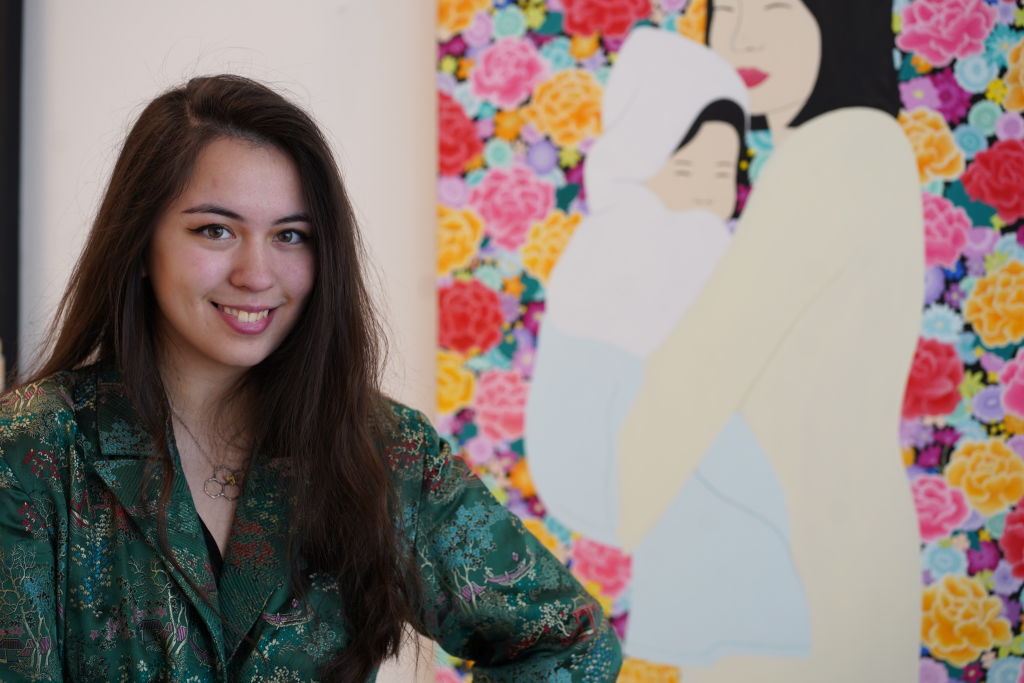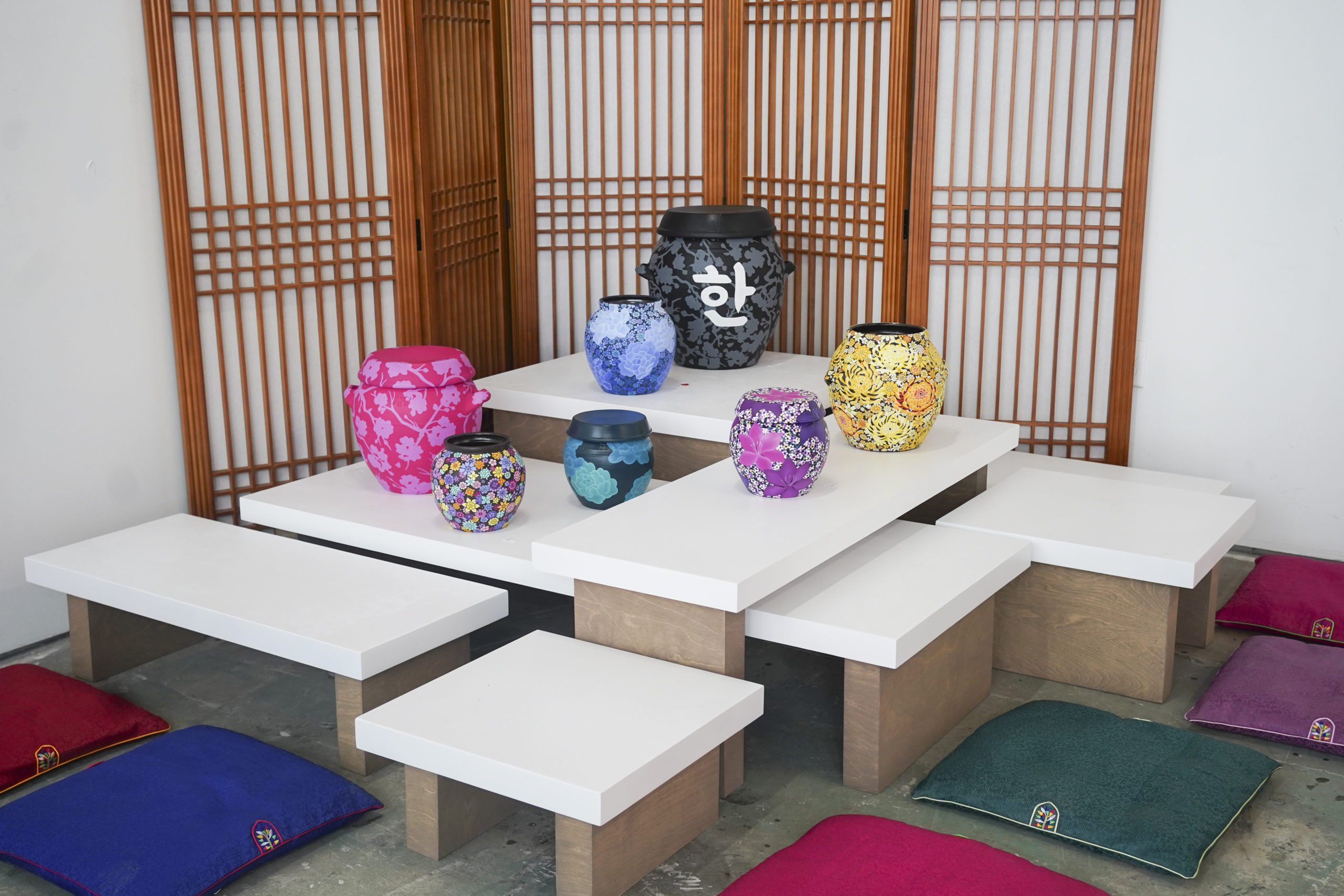Culture
 Julia Chon. Photo by Nicole Schaller.
Julia Chon. Photo by Nicole Schaller.
Artist Julia Chon Creates + Archives Korean American Culture
April 29, 2022 @ 9:00am
One of the biggest gripes older generations have with Gen Z and millennials is their indecisiveness and lack of commitment. Artist Julia Chon — better known as Kimchi Juice — defies this stereotype.
“I was maybe 13 or 14 when I decided to be a professional artist and do this forever,” Chon recalls.
Working with an art tutor after school at 12 years old to learn the foundations, by eighth grade she made her career decision. Chon used art as an emotional outlet through her parents’ divorce, wasting no time pursuing her aspirations.
“I realized if I went to a brick-and-mortar high school, it wouldn’t give me enough time to practice or pursue art because I’d be so busy with [academics],” Chon says. “I proposed homeschool to my parents or this online program to get my high school degree.”
The Korean American artist was surprised when her parents agreed. Chon enrolled in an online high school program, noting, “My parents kind of took a chance on me.”
The chance paid off. She started showing her work at 15 and quickly became part of the D.C. art community when Kelly Towles invited her to D.C. Walls festival (Pow Wow D.C. at the time).
“When I did my first mural for Pow Wow D.C. at 17, it was all very new and exciting,” Chon says. “[It was] also nerve wracking because I felt a tremendous amount of pressure to prove myself and show I was just as talented and deserving as artists working for a long time.”
Now 22 – still considered quite young in her field – Chon has garnered attention for her mural work, which often incorporates Korean imagery and women clothed in traditional hanboks. With clean, crisp linework and a punchy color palette, Chon’s two-dimensional illustrations feel refreshingly modern while still honoring the past. She has painted murals for the Metropolitan Bike Trail and Culture House, as well as working on murals beyond the DMV, including for the mural festival in Seoul, South Korea prior to the Covid-19 shutdown.

Julia Chon with her painting of her grandfather’s family. Photo by Nicole Schaller
Paying Homage
One of the biggest changes that spurred Chon’s growth was the pandemic. With quarantine in place, Chon could no longer travel to do mural work, and instead refocused on creating pieces for shows. As I sat with Chon at her first solo exhibit at HOMME Gallery on L Street, which ran from April 2 to April 16 last month, she once again proved her ability to transform dreams into reality.
The room is full of portraits of her family based on photographs from her grandmother’s albums and collections.
“I have been playing with this body of work in the back of my mind for a long time. I wanted the theme to be family-oriented because I’m very close to my family. I come from a big Korean family. My grandmother had seven daughters.”
Two of the portraits are of her grandmother, displayed side-by-side.
“One is where she’s holding my mom,” Chon points to the painting where a young woman is holding a baby, “and in the other one, she is in yellow. She’s a bit older and is wearing her traditional hanbok dress.”
Another prominent painting includes a full portrait of her grandfather’s family. Each of the paintings offer a window into a time and moment of gratitude and love.
While too premature to be a full-circle moment, she made it a point to center her first D.C. solo exhibit on her family as a thank you.
“My family supported me my entire career, so I wanted to pay homage and tribute. I wanted to dedicate it to them.”
Flowers are also central to the exhibit and Chon’s larger narrative of work. Many of the portraits’ backdrops include flowers, with some symbolizing a larger meaning. Specifically, a painting that shows a woman dressed in white holding a child, which was based off a client’s photo whose mother passed away in childbirth.
“The mums are traditionally seen in funerals,” Chon says about the painting. “It’s a flower of death. It’s when I started doing this freehand of tiny flower patterns in the background with prominent, larger flowers to juxtapose it. [From there] it evolved into more of a theme.”

Painted kimchi pots by Julia Chon // Kimchi Juice. Photo by Nicole Schaller.
The theme transfers over into her painted kimchi pots, which are adorned with different intricate flower patterns and designs, each pot dedicated to a monochromatic palette. Moving over to ceramics is a new venture for Chon, but the new medium still focuses on celebrating her heritage.
“I purchased them at H Mart and painted on them. It’s a tribute to this memory of making kimchi with my family. This was my latest body of work for this exhibit. The yellow pot took about six months to paint.”
The yellow kimchi pot, which includes a range of different flowers in shades of yellow, was nothing short of a labor of love. The piece was recently acquired into the Smithsonian’s permanent collection via the Anacostia Museum’s research project on Korean American foodways.
The Smithsonian acquiring her work carries a lot of weight for Chon, whose favorite part of living in D.C. includes the accessibility to museums — even though contemporary Asian artists are not often highlighted.
“I realized there weren’t a lot of Asian Americans represented [at the Smithsonians]. I just want Asian American artists to be represented and reflected within museums. It’s a matter of just spotlighting and giving attention to it.”
View this post on Instagram
Creating the Spotlight
Chon’s work often falls into the category of honoring and uplifting the Korean American community by showcasing the past to uplift those in the present. The Korean Archives, a photo archive Chon runs dedicated to preserving the Korean diaspora and sharing people’s stories, is a prime example.
“I originally just wanted to share family photos of my ancestors who looked so cool and stylish,” Chon says. “Then it became a grassroots community effort where people just started submitting their family photos and it evolved from there. We now have more than 10,000 followers [on Instagram.]”
The project’s rapid success caught the attention of journalist Lisa Ling, who featured Chon in her HBO Max series “Take Out” and for her efforts in spotlighting Korean Americans through her archive and artwork.
“It was unexpected and I’m very grateful for it,” Chon says about the experience. “I don’t proclaim to represent the whole Korean American community, but to be a part of it is really cool.”
Chon’s activism is organic. When she started off as an artist, she was not focused on a larger message of social justice. She was inspired by her surroundings and the people she loved and cared for.
“My grandfather always tells me to paint from the heart.”
And for Chon, her heart is family and her larger Korean heritage and community — specifically the women in her life who encouraged and guided her as an artist.
Her mother is an entrepreneur herself who works in the culinary industry. She was an integral part of making sure Chon considered the business side of becoming an artist so she could successfully achieve her dreams.
Over time though, Chon realized painting Asian women as an Asian woman carried a larger narrative.
“As I became more established in my career and became more aware of what’s going on in the world, I did realize there aren’t a lot of portrayals of Asian women from the viewpoint of an Asian woman. So, I think that became more of a consideration as time went on.”
The exponential increase of AAPI hate crimes during Covid — especially toward women — has also affected her work.
“It was a very hard time for the people in our community and it made me much more reflective on the intention behind my work and what messaging I want to put forth going forward,” Chon says.
Part of her efforts include creating more platforms for Asian American artists, like partnering with other AAPI artists last year to curate an AAPI show in LA. They are planning to do it again this year, as well.
As for Chon’s immediate future, she is currently working on a mural collaboration in LA with another Korean American artist, Annie Hong, to commemorate the LA riots and has an upcoming solo exhibition in Denver that will feature all new art.
For most, finding one’s life’s work and mission takes many years and constantly evolves. Chon is a true outlier, with an unwavering belief in who she is and what she can bring to this world.
“I always knew, without consciously knowing, that art was the path I would have to take.”
To learn more about Julia Chon and her work, follow her on Instagram @kimchi.juice. To learn more about The Korean Archives, follow on Instagram @koreanarchives.
Enjoy this piece? Consider becoming a member for access to our premium digital content. Support local journalism and start your membership today.







